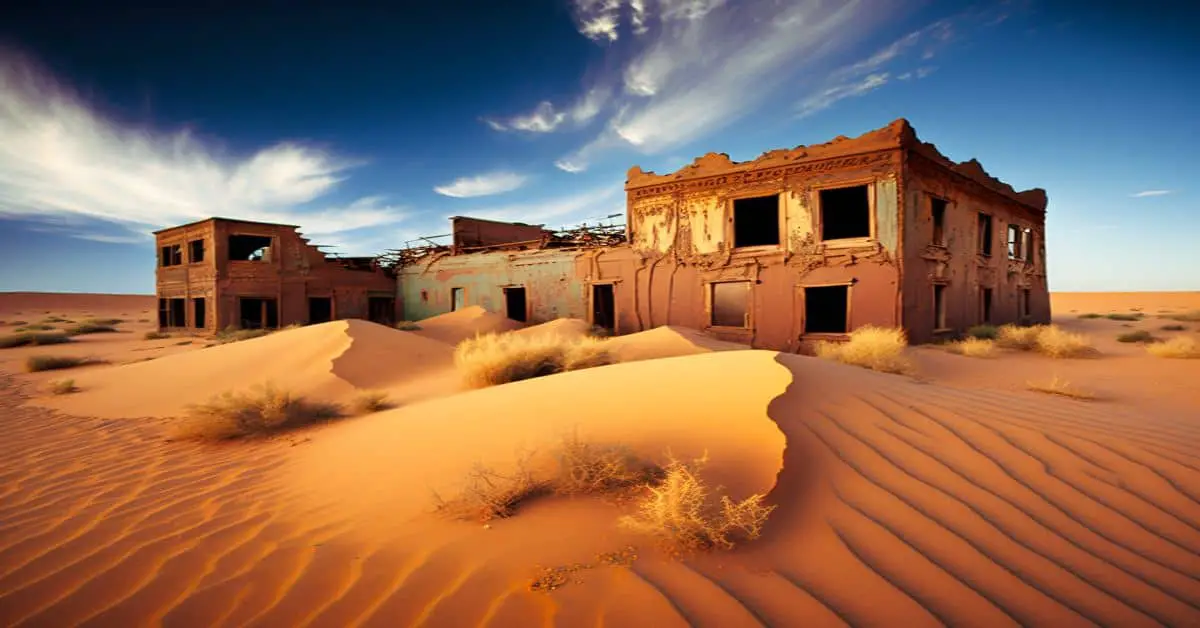Death Valley is home to many ghost towns and abandoned communities that once thrived in harsh conditions. Towns in Death Valley had their heyday during mining when it was common for settlers and prospectors from nearby cities like Los Angeles or Las Vegas to go out looking for gold.
Still, after ore became scarce (usually because most deposits have been mined), life quickly drained away until only ruins remained. These structures include hotels with names such as “The Pioneer” and restaurants called “Genesis End,” among others.
Located in California’s Death Valley, these ghost towns offer a glimpse into the past. Furnace Creek was once home to around 3,000 people but has since declined mainly due to mining operations that were eventually shut down. What is left is primarily covered in cacti and sand.
Ballarat, California
Ballarat is a town in California’s Death Valley region initially known for its gold mining heyday. This small Australian settlement had over 400 residents when it first opened. Still, today only about 30 live here permanently – most of them with their legacy left behind by those days long gone.
Ballarats’ rich history has been preserved through memorials like these iconic ruins remaining from old times: The buildings are mostly intact though they’ve suffered some wear & tear.
Chloride City, California
Chloride City is an abandoned town in California that became famous for its ghostly reputation. The Bullfrog strike led many people to move into the area and re-stake old mining claims, which created a problematic situation.
Only one year later, they left without saying goodbye or telling anyone what had happened. Plenty of adits (shortcuts) may explain how these settlements managed to stay afloat after others had fallen apart from neglecting their maintenance responsibilities – some even say it could’ve been because of Hell’s Gate.
Greenwater, California
When the copper mines in Greenwater, California, were struck with success—a town was born. The population grew from just over 100 people at its peak to around 2 thousand inhabitants! However, by 1909, mining had collapsed without ever showing any profit.
Many residents left permanently or returned less often because they could no longer afford to live there while trying to work in other areas. Nothing but ruins remain today, aside from one old tree standing tall among brushy mountainsides near Dante’s View.
Harrisburg, California
Harrisburg, California, is a ghost town that was initially going to be named after two men who found gold in 1905. However, Shorty Harris took credit for the strike and changed its name from Harrisberry to Harrisburg.
This mine’s original location resides at Aguereberry Point just off Highway 101 near Eureka, with only one reminder left: Pete’s Home Mine & Pit Boxes, standing about 2 miles down the dirt road right outside of Humboldt Redwoods State Park.
Leadfield, California
When Charles C. Julian, a flamboyant California promoter, took over as the town’s president in 1926, he brought significant numbers of people into this area which had been mined for copper and led since 1905. Still, it wasn’t until technological improvements that these sorts of investments became profitable after World War I.
The fate of this little town was tied to Charles Julian and the local mining operations. When he experienced a financial downfall, it directly ended their survival as miners because they no longer had any profitability to keep up appearances – let alone payoff debts!
Mining and town remains can be found throughout the area. There are even some old buildings left standing though most have long since fallen apart or been torn down.
Panamint City, California
The citizens of Panamint City were living in a boom town during the height of its silver-rush days. With an influx of criminals who gave up their livelihood to hide near Surprise Canyon, this little hellhole became more civilized than expected, with stores and churches popping up everywhere!
When the boom was over in 1875, a flash flood destroyed most of Panamint City. Mining continued on occasion up until recent times when it stopped entirely due to a lack of rainwater flow through ephemeral streams lined each side of Entrada Wash – Bean Butte Canyon Highway ( highway marker near monument S constructed by Bureau Of Land Management).
The only remaining reminder of its heyday is these ruins which can be accessed via an easy 5-mile hike from Chris Wicht’s campsite located just 6 miles northeast down Ballarat Road towards Furnace Creek Rancho Chico.
Rhyolite, California
Rhyolite, the “Queen City” of Death Valley, was a bustling town with a population exceeding 5 thousand people during its height from 1905-1911. The city contained two churches and 50 saloons in addition to other stores, such as 18 grocers or shops that sold clothing at affordable prices.
Still, you could find anything else if it had some use! It was not uncommon to see independently provided funerals and processions as the dry heat, and hard ground created a challenge for life and death.
Skidoo, California
In 1906, two prospectors found gold on their way to the Harrisburg strike. They eventually founded Skidoo as a mining town with an estimated population of 700. It became famous when Death Valley’s only hanging took place in 1910.
Hootch Simpson tried robbing banks in the area but got caught after killing a store owner during an attempted robbery. Legend has it that Hootch, the town’s evil mastermind, and crime leader, was hung by town citizens at night. Due to its steep slopes, Skidoo is located off Wildrose Road, which isn’t recommended for automobiles.
Foot travel is the only suitable method of reaching the town. Local law enforcement officers are ready to issue tickets and pursue charges for anyone caught driving the roads, especially after sunset. Nothing remains of the actual townsite.



